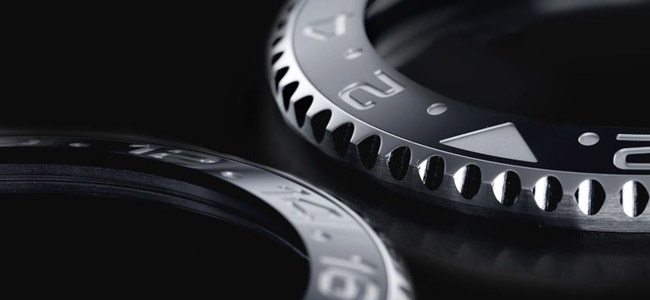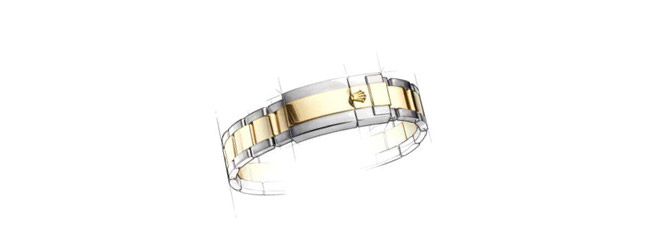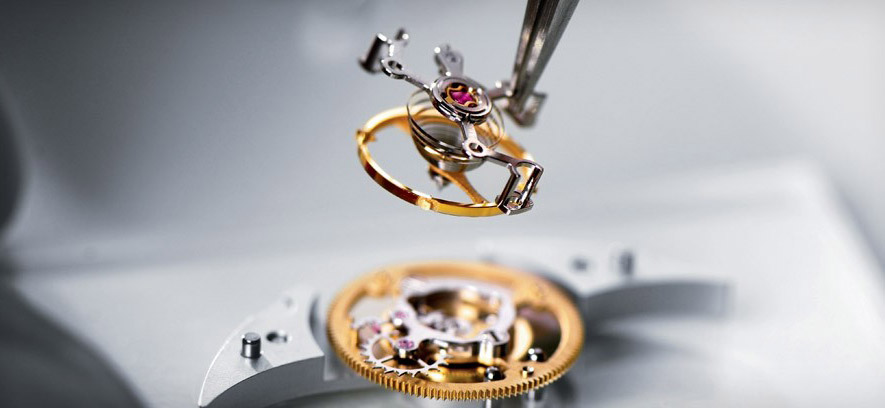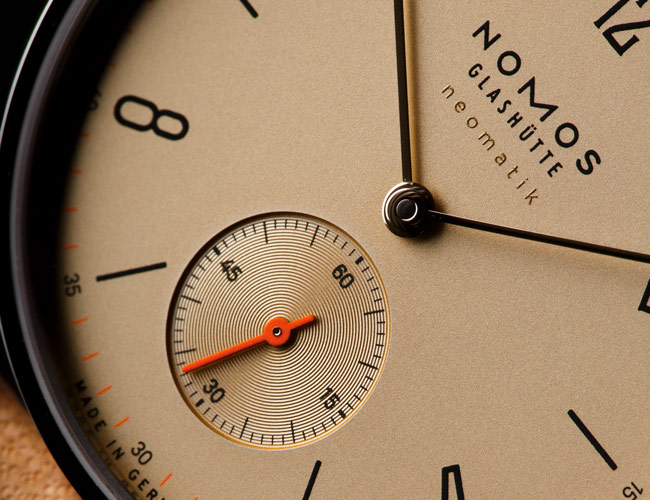Like cars and computers, the terminology behind watches is almost as complicated as the mechanics that drive them. Diehard watch nerds throw around familiar terms like “caliber,” “frequency” and “complication” with little regard for an outsider’s knowledge of what they mean in a watch context; they also spout simple jargon that means a lot (“jewels”) and intimidating terms that are actually simple (“Manufacture d’Horologie”). For the timekeeping newbie, a simple glossary will help cut the confusion — consider this your reference point.
Automatic: A mechanical watch that is wound by the motion of the wearer’s wrist, rather than by twisting the crown. The motion of the wrist moves a counterweight (called a rotor) that then powers the mainspring, which turns the watch’s gears.
Balance Wheel: A weighted wheel that oscillates at a constant rate (usually one oscillation per fraction of a second), moving the watch’s gears and allowing the hands to move forward
Balance Spring: A delicate spring (often made from metal but sometimes silicon) attached to the balance wheel that regulates the rate at which a balance wheel oscillates. The balance spring is also often referred to as a hairspring.
Barrel: The cylindrical, enclosed apparatus with geared teeth that contains the mainspring, thus houses the watch’s power reserve. A watch’s power reserve can be expanded by adding additional barrels.

A Rolex Cerachrom (ceramic) bezel.
Bezel: A metal (though occasionally ceramic) ring that surrounds the watch crystal. Often bezels rotate on watches (usually on dive watches) and contain a scale for time or other measurements; some remain stationary or do not have a scale and are purely decorative. (Learn more about different kinds of bezels here.)
Bridge: A plate or bar that is mounted to the mainplate, forming a frame that houses the inner workings of a mechanical watch.
Caliber: A synonym for movement, most often used when a manufacturer is denoting a specific model name for a movement.
Case Back: The reverse side of a watch case that can be removed to access the inside of the watch.
Chronograph: A type of watch that features an additional stopwatch function in addition to the main time. A chronograph can be either quartz or mechanical (or a hybrid of the two) and is activated via a set of pushers protruding from the side of the case. (See some of our favorite modern chronographs <a href="https://here.)
Chronometer: A watch that has been independently tested by the Official Swiss Chronometer Testing Institute (COSC) in Switzerland (or any other official governing body in other countries). In the case of the former, watches are tested over the course several days in six different positions at three different temperatures, while remaining accurate to within -4/+6 seconds per day for mechanical watches and ±0.07 per day for quartz watches. (Learn more about chronometers here.)
Complication: An additional function of a watch that goes beyond telling the time, like a stopwatch (chronograph), calendar or a moonphase indicator. Complications require additional parts and make a watch more expensive and complex to build.
Crown: A small knob on the side of the watch case that can be used to adjust the time, date and — if your mechanical watch isn’t automatic — wind the watch to keep it running.

Crystal
Crystal: The clear protective cover that shrouds the watch face, made from either synthetic sapphire, acrylic or glass. Synthetic sapphire is the most expensive to produce, though it is considerably more scratch resistant than either acrylic or glass crystals. (Learn how to fix a scratched watch crystal here.)
Deployant Clasp: A type of watch strap buckle that closes by folding in on itself, then clasping. Makes the strap easier to take on and off and keeps the leather from getting worn or stretched out.
Dial: Also often referred to as the face, the dial displays the time and features numerals and markings as well as the hands. (See some of our favorite dial designs here.)
Dive Watch: A dive watch is a water-resistant watch, but not all water-resistant watches are dive watches. True dive watches should meet a specific standard for diving like ISO 6425, which requires the watch to be water-resistant to at least 200 meters, feature a unidirectional rotating bezel and some form of illumination.

Escapement
Escapement: An internal component in a mechanical watch that transfers the power from a wound-up watch into the movement of the watch’s seconds hand by driving the balance wheel at a steady rate. Most modern watches use a “lever escapement,” comprised of an escape wheel and a lever with two pallets. The escape wheel is connected to the gear train (which receives energy from the mainspring) and the lever and pallets lock and unlock the escape wheel at a steady rate. This component is responsible for a watch’s ticking noise.
Exhibition Case Back: Also called an “open” case back, this is a transparent cover on the backside of a watch case that shows off the inner workings of the movement.
Frequency: The speed at which a watch ticks (or beats), measured in either vibrations per hour or hertz. Most modern, high-end mechanical watches beat at a frequency of 28,800 VpH (4Hz). Watches that beat at 36,000 VpH (5Hz) or higher are considered to be high-beat watches. A watch’s frequency is controlled by the oscillations of its balance wheel.

A Rolex deployant clasp
Flyback Chronograph: A type of chronograph that can be reset without stopping the chronograph function (which is necessary in a normal chronograph). It’s particularly useful among pilots and other users who need to record multiple times in quick succession. (Learn more about chronographs here.)
Gasket: A rubber, neoprene or plastic ring used to seal the gaps between the case and the case back, crystal and crown to prevent water or dust from entering the case and damaging the movement inside.
Gear Train: A system of gears that transfer power from the mainspring to the escapement.
GMT: Though it stands for Greenwich Mean Time, a watch referred to as a GMT has the ability to track two time zones at once. Originally developed by Rolex for pilots in the ’50s, they’re particularly useful for any frequent flyer. (See some of our favorite GMT watches here.)
Guilloche: An engraved ornamental pattern, often used on watch dials, comprised of intricately intertwined lines. (Learn more about guilloche here.)
Hacking Seconds: Also called “stop seconds,” this function will stop the seconds hand when the crown is pulled out. This makes it easier to synchronize a watch with another timepiece.
Hand-wound: Referring to a mechanical watch that doesn’t automatically wind. Hand-wound watches are powered by manually turning the crown to wind up the mainspring.
Haute Horlogerie: Translated to English, this French term means “high watchmaking,” and is used to distinguish watches or watchmakers that demonstrate extreme proficiency in watch design, technical innovation and finishing.
Horology: The art and/or science of measuring time.
Hybrid Smartwatch: A classically-styled analog watch (usually quartz-powered) that also features digital smart functions like activity tracking and push notifications. (Read our review of one of our favorite hybrid smartwatches here.)
Indices: The markings on the dial of a watch used to represent the hours in place of numerals. In higher-end watches, these are usually “applied,” or attached to the dial, rather than printed on.

Jewels
Jewels: Synthetic rubies (sometimes synthetic sapphires) used as bearings at the heaviest points of wear in a watch movement in order to reduce friction between moving parts and increase a movement’s lifespan. Jewels have a naturally slicker surface than metal — for example, the coefficient of friction between two pieces of steel is about 0.58, while the coefficient of sapphire on steel is about 0.15. Jewels are only used to increase the accuracy of the movement and are not for decoration.
Lugs: The protruding pieces of metal at the top and bottom of a watch case where the strap is attached. The two ends of the lug hold a spring bar, which holds the strap in place.
Luminescence: Colloquially referred to as “lume,” luminescence is the glow given off by watch numerals, indices and hands that have been coated with a photoluminescent material (“lumed”). While early watches used radioactive radium to create lume, most modern watches use non-radioactive phosphorescent substances like strontium aluminate. (Learn about the dark history of luminescent watches here.)
Magnetisim: Metal components inside a watch can often be magnetized when introduced to magnetic fields, thus causing a serious loss of accuracy. This happens mostly when the balance spring becomes magnetized and sticks to itself, causing the watch to run faster than usual. Fortunately, this problem can be fixed quickly and easily at a watchmaker (or at home, even). It is enough of a problem, however, that some high-end watchmakers use soft-iron cages to protect the movement from magnetic fields, or use silicon balance wheels that do not become magnetized. (Learn more about anti-magnetic watches here.)
Mainplate: The base on which all the parts of a mechanical watch movement are mounted.
Mainspring: A torsion spring that becomes tightened when a watch is wound, thus storing the energy of a watch. The force of the spring unwinding powers the watch. The mainspring is housed inside a small drum called a “barrel.”
Manufacture d’Horologie: A French term, usually shortened to “manufacture,” that refers to a watch company that develops its own parts (including its movements) at its own facility (“in-house”), rather than assembling watches from parts made by third-party part suppliers.

Three Patek Philippe movements: Automatic, Manual and Quartz
Movement: The inner-working mechanism of a watch that can be either mechanical (automatic or hand-wound) or quartz (battery powered). Most watch manufacturers refer to their movements as “calibers.” In a mechanical movement, the main components are a mainspring, a gear train, an escapement and a balance wheel. In a quartz movement, the main components are a battery, a microchip circuit, a quartz crystal and a stepper motor. Many high-end movements (both quartz and mechanical) are manufactured in Switzerland by either watch brands themselves or from large movement makers like ETA and Valjoux, though Japan and even China have their own thriving watchmaking industries.
Power Reserve: The length of time that a mechanical watch can run once it’s fully wound. Most entry-level watches have a power reserve of about 40 hours, though many higher-end watches can run for several days at a time. Sometimes watches will feature a power reserve gauge indicating how fully wound the watch is.
Pusher: A button on a chronograph watch that starts, stops and/or resets the chronograph mechanism. The majority of chronographs have two pushers — one for starting and stopping the mechanism, and another for resetting.
Quartz: A quartz watch is a battery-powered watch. The battery sends an electric signal via a microchip circuit to a small quartz crystal that then vibrates at a precise rate. Those vibrations regulate a stepper motor that moves the watch hands. Quartz watches are considerably more accurate, more reliable and cheaper than their mechanical counterparts, though mechanical watch diehards don’t find them as appealing because of their simpler internal components. (See some of our favorite quartz watches here.)
Rattrapante Chronograph: Also called a double chronograph or split-seconds chronograph, this adds an additional seconds hand and pusher to the standard chronograph function. The additional seconds hand moves in sync with the standard seconds hand, but stops when the extra pusher is depressed, allowing the user to record two times at once. (Learn more about rattrapante chronographs here.)
Repeater: A high-end complication that chimes to denote the time at the push of a button on the watch case.
Retrograde: An indicator on a watch dial that forms a segment of a circle, rather than a full circle. When the indicator goes through a full cycle, it resets back to the zero position by moving backward. Often used to indicate hours, minutes or dates.
Silicon: This metalloid is growing more and more common in watchmaking (mostly in balance springs and escapements), as it does not react to changes in magnetism and temperature like metal does and does not require lubrication. As such, watches with these silicon components are often more accurate, more reliable and more resistant to magnetism than their counterparts using metallic components.
Skeleton: Similar to an exhibition case back, a skeleton watch shows off the inner workings of the watch, but does so through a transparent or partially cut-out dial so that the movement can be viewed from the front of the watch.
Small Seconds: A small sub-dial separate from the main hour and minute function that displays the seconds.

An IWC tourbillon
Tourbillon: A type of escapement housed in a rotating cage that is meant to counter the negative effects gravity on a movement. While the movement was originally intended for pocket watches, they’ve moved to wristwatches as a way to showcase the height of a manufacture’s watchmaking abilities, and as such, they command exorbitant prices. (Learn more about tourbillons here.)
Winder: A box or case (or vault if you have the means) that gently rotates an automatic watch to keep the mainspring fully wound when it isn’t being worn. (You can learn more about watch winders here.)
World timer: A watch with a dial that can be adjusted to show the time in 24 different time zones represented by 24 major cities across the globe. (See some of our favorite world time watches here.)
How a small town in Germany became an epicenter for fine watchmaking. Twice. Read the Story


